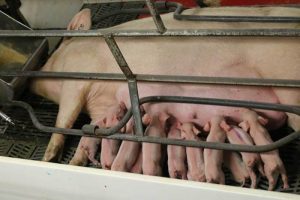
Dive into the world of Livestock management systems where efficiency meets sustainability, offering a unique perspective on modern farming practices that are both innovative and environmentally conscious.
Discover how technology is revolutionizing the way livestock is managed and the impact it has on animal welfare, sustainability, and productivity.
Livestock Management Systems

Livestock management systems refer to the organized and efficient methods used to oversee the care, breeding, feeding, and overall well-being of livestock animals. These systems are essential for ensuring the health and productivity of the animals, as well as for maximizing profitability for farmers.
Importance of Implementing Efficient Livestock Management Systems
Efficient livestock management systems are crucial for several reasons. Firstly, they help farmers monitor the health and wellness of their animals, allowing them to detect and address any issues promptly. Secondly, these systems enable farmers to optimize feeding schedules, breeding programs, and overall productivity, leading to higher yields and profits. Lastly, proper management systems ensure compliance with regulations and ethical standards in animal agriculture.
Key Components of a Successful Livestock Management System
- Animal Identification and Tracking: Assigning unique identifiers to each animal and keeping track of their health records, breeding history, and other relevant information.
- Health Monitoring and Disease Management: Regular health check-ups, vaccinations, and proactive measures to prevent and control diseases within the herd.
- Feed and Nutrition Management: Planning and implementing balanced diets to meet the nutritional needs of different animals at various stages of growth and production.
- Reproduction and Breeding Programs: Strategically managing mating, artificial insemination, and genetic selection to improve the quality of the herd.
- Facility and Environment Management: Maintaining clean, safe, and comfortable living conditions for the animals, including proper ventilation, lighting, and space.
Technology in Transforming Livestock Management Systems
Technology has revolutionized livestock management systems, providing farmers with advanced tools and software to streamline operations and improve efficiency. From automated feeding systems and remote monitoring devices to data analytics and predictive modeling, technology allows farmers to make data-driven decisions and optimize their livestock production practices like never before.
Animal Welfare in Livestock Management
Animal welfare plays a crucial role in livestock management systems as it not only ensures the well-being of the animals but also has a direct impact on their productivity and overall quality of products derived from them. Ethical considerations are paramount when designing livestock management systems to guarantee that the animals are treated humanely and their natural behaviors and needs are met.
Importance of Animal Welfare
- Proper animal welfare leads to healthier and happier animals, resulting in higher productivity and better quality products.
- Ensuring animal welfare can help prevent diseases and reduce stress in livestock, leading to improved growth rates and reproductive performance.
- Consumers are increasingly concerned about the welfare of animals in agriculture, making it essential for farmers to prioritize animal welfare to maintain consumer trust and loyalty.
Ethical Considerations in Livestock Management
- Providing adequate space, shelter, and access to clean water and food are basic ethical considerations in livestock management.
- Avoiding overcrowding, implementing proper handling techniques, and minimizing the use of harsh practices like tail docking or dehorning are crucial for maintaining animal welfare.
- Regular monitoring of animal health, behavior, and living conditions is necessary to ensure that ethical standards are being met.
Best Practices for Ensuring Animal Welfare
- Implementing proper vaccination programs and disease prevention measures to safeguard animal health.
- Providing comfortable and clean living conditions, including appropriate bedding and ventilation, to promote animal well-being.
- Offering enrichment activities and opportunities for natural behaviors, such as grazing or nesting, to enhance animal welfare.
Impact of Improved Animal Welfare on Productivity
- Studies have shown that animals with higher welfare standards exhibit better growth rates, reproduction, and overall health, leading to increased productivity in livestock farming.
- Reducing stress and ensuring proper nutrition and care can result in higher feed conversion rates and improved efficiency in meat, milk, and egg production.
- Improved animal welfare can also lead to decreased mortality rates and veterinary costs, ultimately benefiting the farmers economically.
Sustainable Practices in Livestock Management
Implementing sustainable practices in livestock management is crucial for the well-being of animals, the environment, and the overall success of the industry. By adopting environmentally friendly methods, we can ensure a balance between productivity and conservation.
Sustainable Practices Adopted in Modern Livestock Management Systems
Modern livestock management systems have incorporated various sustainable practices to minimize environmental impact and promote animal welfare. Some of these practices include:
- Rotational grazing to prevent overgrazing and maintain soil health.
- Utilization of renewable energy sources such as solar power for operations.
- Water conservation techniques to reduce wastage and maintain water quality.
- Integration of precision farming technologies to optimize feed efficiency and reduce emissions.
Environmental Impact of Livestock Farming and Mitigation Strategies
Livestock farming can have significant environmental impacts such as deforestation, greenhouse gas emissions, and water pollution. To mitigate these effects, management systems can implement strategies like:
- Implementing manure management plans to reduce nutrient runoff and water contamination.
- Using feed additives to reduce methane emissions from livestock.
- Investing in infrastructure for waste treatment and recycling.
Comparison of Traditional vs. Sustainable Livestock Management Practices
Traditional livestock management practices often rely on intensive farming methods that can lead to soil degradation, biodiversity loss, and resource depletion. In contrast, sustainable approaches prioritize long-term environmental sustainability, animal welfare, and economic viability.
Examples of Successful Sustainable Livestock Management Systems Globally
Several countries have successfully implemented sustainable livestock management systems that serve as models for the industry. For instance, New Zealand’s grass-fed beef production emphasizes pasture-based systems that promote animal health and environmental conservation. Similarly, Denmark’s organic dairy farms focus on biodiversity preservation and reduced chemical use, showcasing the benefits of sustainable practices in livestock management.
Wild Animals in Livestock Management
Wild animals play a significant role in livestock management, posing both challenges and opportunities for farmers. Managing interactions between wild animals and livestock is crucial to ensure the safety and well-being of the animals, as well as the success of the farm. Strategies to protect livestock from predators in wild animal habitats are essential to minimize losses and maintain a sustainable operation.
Wildlife conservation efforts can also have a positive impact on livestock management by creating a balance between preserving natural habitats and ensuring the safety of domestic animals.
Challenges of Managing Interactions Between Wild Animals and Livestock
- Competition for resources such as food and water
- Risk of predation leading to livestock losses
- Potential transmission of diseases between wild and domestic animals
Strategies to Protect Livestock from Predators in Wild Animal Habitats
- Implementing secure fencing around pastures and enclosures
- Using guard animals such as dogs or llamas to deter predators
- Installing motion-activated lights or sound devices to scare off wildlife
Case Studies on Wildlife Conservation Impacting Livestock Management
- In Yellowstone National Park, reintroduction of wolves helped regulate elk populations, reducing conflicts with ranchers in surrounding areas
- In Africa, conservation efforts to protect lions and other predators have led to improved coexistence with livestock farmers through community-based conservation programs
- In Australia, fencing projects and predator control programs have successfully reduced livestock losses to wild dogs and dingoes
Balancing Wildlife Conservation and Successful Livestock Management
- Implementing sustainable farming practices that consider the needs of both wildlife and livestock
- Collaborating with wildlife experts and conservation organizations to find mutually beneficial solutions
- Using technology such as GPS tracking and remote monitoring to mitigate conflicts and track animal movements
Epilogue

Explore the intricate balance between wildlife conservation and successful livestock management, highlighting the importance of ethical considerations, best practices, and sustainable approaches.
FAQ Explained
How can technology improve livestock management systems?
Technology can enhance efficiency by tracking animal health, monitoring feeding schedules, and optimizing breeding practices.
What are the key components of a successful livestock management system?
Key components include proper nutrition, efficient breeding programs, disease control measures, and adequate housing facilities.
How do sustainable practices benefit livestock management systems?
Sustainable practices help reduce environmental impact, improve animal welfare, and ensure long-term viability of farming operations.





